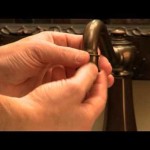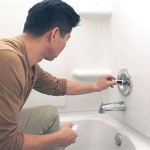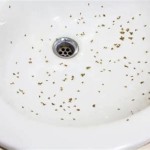How To Replace a Bathroom Ceiling Vent Fan
Bathroom ceiling vent fans are essential for maintaining air quality and preventing moisture buildup, which can lead to mold and mildew growth. Over time, these fans can become noisy, inefficient, or even stop working altogether. Replacing a bathroom ceiling vent fan is a common home improvement task that can be accomplished by a homeowner with basic electrical knowledge and some readily available tools. This article provides a detailed guide on how to safely and effectively replace a bathroom ceiling vent fan.
Before beginning any electrical work, safety is paramount. The first and most crucial step is to disconnect the power supply to the bathroom circuit at the main electrical panel. Locate the circuit breaker that controls the bathroom electricity and switch it to the "OFF" position. To ensure the power is completely off, it is advisable to use a non-contact voltage tester to verify that no electricity is flowing to the existing fan fixture. This simple precaution can prevent electric shock.
Next, gather the necessary tools and materials. Essential tools include a screwdriver set (both Phillips head and flathead), wire strippers, wire connectors (such as wire nuts), a utility knife, a ladder, safety glasses, and work gloves. You will also need the replacement vent fan unit, which should be carefully selected based on the size of the bathroom and the existing ductwork. Consider the cubic feet per minute (CFM) rating of the fan; a higher CFM is suitable for larger bathrooms. A general rule is 1 CFM per square foot of bathroom area. Duct tape or foil tape will be needed for sealing the duct connections, and possibly some shims (wood or plastic) for leveling the fan housing.
With the power safely disconnected and the necessary tools and materials assembled, the process of removing the old fan can begin. Start by removing the fan cover. Most covers are held in place by spring clips or screws. Carefully detach the cover and set it aside.
Once the cover is removed, the fan motor and blower assembly will be visible. Disconnect the electrical wiring to the motor. This typically involves removing wire connectors or unscrewing terminals. Take careful note of the wire connections before disconnecting them, as this will be crucial for connecting the new fan correctly. It is often helpful to take a photograph of the wiring configuration for reference. Once the wires are disconnected, the motor and blower assembly can usually be removed by unscrewing or unclipping it from the fan housing.
The next step is to detach the fan housing from the ceiling joists. The housing is typically attached using screws or nails. Use a screwdriver or pry bar to remove these fasteners. Be cautious when removing the housing, as it may be heavy and could fall. If the housing is attached to ductwork, carefully detach the duct from the fan housing. Duct tape or foil tape might be used to seal the connection; remove this tape to release the duct. With the housing detached, carefully lower it from the ceiling.
Before installing the new fan, inspect the existing ductwork. If the duct is damaged or deteriorated, it should be replaced. Ensure the duct is properly insulated to prevent condensation. If the existing hole in the ceiling is too large or too small for the new fan housing, adjustments may be necessary. Patching the ceiling with drywall compound might be required if the hole is too large. Expanding the hole might involve cutting drywall, which should be done carefully using a utility knife or drywall saw.
Key Point 1: Electrical Safety and Preparation
The first key point emphasizes the importance of electrical safety. Neglecting to disconnect the power before working on electrical components can lead to serious injury or even death. Always double-check that the power is off using a non-contact voltage tester. Equally important is proper preparation: having all the necessary tools and materials readily available will streamline the replacement process and minimize potential delays or complications. Selecting the correct replacement fan, based on the bathroom size and existing ductwork, is also crucial for optimal performance.
With the opening prepared and the ductwork inspected, the new fan housing can be installed. Follow the manufacturer's instructions for attaching the housing to the ceiling joists. Ensure the housing is securely fastened and level. Shims can be used to level the housing if necessary. Connect the ductwork to the fan housing using duct tape or foil tape. Seal the connection tightly to prevent air leaks. Air leaks can significantly reduce the efficiency of the fan and contribute to moisture buildup.
Once the housing is securely installed, the electrical wiring can be connected. Refer to the photograph or notes taken during the removal of the old fan to ensure the wires are connected correctly. Typically, there will be a black (hot) wire, a white (neutral) wire, and a green (ground) wire. Use wire connectors to connect the corresponding wires. Ensure the connections are secure to prevent loose wires, which could create a fire hazard. Tuck the wires neatly into the fan housing and secure them with wire clamps if provided.
The final step is to install the fan motor and blower assembly into the housing. This usually involves screwing or clipping the assembly into place. Ensure the assembly is securely attached and that the fan blades rotate freely. Install the fan cover, securing it with spring clips or screws. Double-check that all components are properly installed and secured before restoring power to the circuit.
After the fan is installed, turn the circuit breaker back to the "ON" position and test the fan. The fan should operate smoothly and quietly. If the fan is noisy or vibrating, it may not be properly secured or balanced. Check the installation and make any necessary adjustments. If the fan does not operate at all, double-check the wiring connections and ensure the circuit breaker is functioning correctly.
Following the initial test, it is important to observe the fan's performance over the next few days. Check for any signs of air leaks around the fan housing or duct connections. Ensure the fan is effectively removing moisture from the bathroom during and after showers or baths. If any issues are detected, address them promptly to prevent further problems.
Replacing a bathroom ceiling vent fan, while a manageable DIY project, can occasionally present unforeseen challenges. These might include encountering unexpected wiring configurations, dealing with difficult-to-reach ductwork, or discovering hidden damage to the ceiling or surrounding structures. If encountering such challenges, it's best to consult a qualified electrician or contractor. Attempting to proceed without adequate knowledge or experience could lead to improper installation, safety hazards, or further damage to the property.
Key Point 2: Proper Ductwork Connection and Sealing
The second key point focuses on the importance of proper ductwork connection and sealing. A poorly connected or improperly sealed duct can significantly reduce the efficiency of the vent fan, allowing moisture to escape back into the bathroom. This can lead to moisture buildup, mold growth, and reduced air quality. Using high-quality duct tape or foil tape to create a tight, airtight seal is essential. Furthermore, ensuring the duct is properly insulated will prevent condensation and further enhance the fan's performance.
Regular maintenance of the bathroom ceiling vent fan is crucial for ensuring its longevity and optimal performance. Clean the fan cover and blades regularly to remove dust and debris, which can reduce airflow and increase noise. Periodically inspect the ductwork for any signs of damage or leaks. Address any issues promptly to prevent further deterioration. Lubricating the fan motor can also help to extend its lifespan and reduce noise. Follow the manufacturer's recommendations for maintenance procedures.
The choice of replacement fan can significantly impact the overall effectiveness and energy efficiency of the ventilation system. When selecting a new fan, consider factors such as the CFM rating, noise level (measured in sones), energy efficiency (Energy Star rating), and features such as humidity sensors or timers. A fan with a humidity sensor will automatically turn on when moisture levels rise, ensuring optimal ventilation. A timer allows the fan to run for a specified period after the shower or bath, further reducing moisture buildup. Choosing a fan that meets the specific needs of the bathroom will result in a more comfortable and healthy environment.
Proper disposal of the old fan is also important. Check local regulations for electronic waste disposal. Many communities have recycling programs for electronic devices, including vent fans. Disposing of the old fan properly helps to protect the environment and conserve resources.
In summary, replacing a bathroom ceiling vent fan is a straightforward task that can be accomplished by homeowners with basic electrical skills and a commitment to safety. By following these detailed steps and taking the necessary precautions, a new fan can be installed effectively, improving air quality and preventing moisture buildup in the bathroom.
Key Point 3: Fan Selection, Testing, and Maintenance
The third crucial aspect is the selection of the appropriate fan, thorough testing after installation, and consistent maintenance. Selecting a fan with the correct CFM rating for the bathroom size is paramount for effective ventilation. Consideration should also be given to features like noise level, energy efficiency, and humidity sensors. After installation, diligent testing ensures the fan operates correctly and efficiently. Regular maintenance, including cleaning the fan cover and blades and inspecting the ductwork, prolongs the fan's lifespan and maintains its optimal performance.
Beyond the functional aspects, consider the aesthetic integration of the new fan. While primarily a utility device, the fan cover can contribute to the overall bathroom design. Some fans come with decorative covers that can complement the bathroom's style. Consider the color, shape, and material of the cover when selecting a replacement fan to ensure it blends seamlessly with the existing decor. The availability of integrated lighting is also something to look at as it is often useful when upgrading the existing system.

How To Install A Bathroom Fan Step By Guide Bob Vila

How To Replace A Bathroom Exhaust Fan Stanley Tools

Remove Install A Bathroom Fan Grille In 1 Min

How To Replace Or Repair A Bathroom Fan

Install A New Bathroom Vent Fan Light

Bath Fan Replacement In 10 Minutes Or Less

How To Replace A Bathroom Exhaust Fan Stanley Tools

How To Install A Bathroom Fan Diy Family Handyman

How To Install A Bathroom Fan Homeserve Usa

Blog
Related Posts







